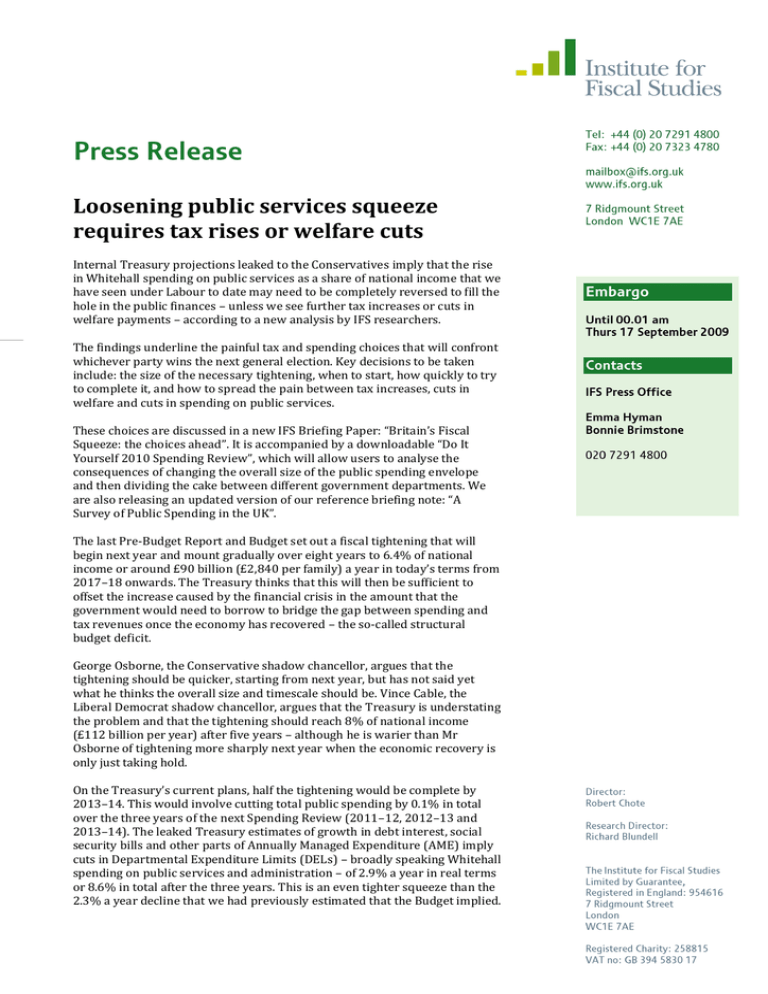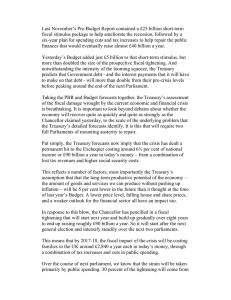Loosening public services squeeze requires tax rises or welfare cuts
advertisement

Loosening public services squeeze requires tax rises or welfare cuts Internal Treasury projections leaked to the Conservatives imply that the rise in Whitehall spending on public services as a share of national income that we have seen under Labour to date may need to be completely reversed to fill the hole in the public finances – unless we see further tax increases or cuts in welfare payments – according to a new analysis by IFS researchers. The findings underline the painful tax and spending choices that will confront whichever party wins the next general election. Key decisions to be taken include: the size of the necessary tightening, when to start, how quickly to try to complete it, and how to spread the pain between tax increases, cuts in welfare and cuts in spending on public services. These choices are discussed in a new IFS Briefing Paper: “Britain’s Fiscal Squeeze: the choices ahead”. It is accompanied by a downloadable “Do It Yourself 2010 Spending Review”, which will allow users to analyse the consequences of changing the overall size of the public spending envelope and then dividing the cake between different government departments. We are also releasing an updated version of our reference briefing note: “A Survey of Public Spending in the UK”. The last Pre-Budget Report and Budget set out a fiscal tightening that will begin next year and mount gradually over eight years to 6.4% of national income or around £90 billion (£2,840 per family) a year in today’s terms from 2017–18 onwards. The Treasury thinks that this will then be sufficient to offset the increase caused by the financial crisis in the amount that the government would need to borrow to bridge the gap between spending and tax revenues once the economy has recovered – the so-called structural budget deficit. George Osborne, the Conservative shadow chancellor, argues that the tightening should be quicker, starting from next year, but has not said yet what he thinks the overall size and timescale should be. Vince Cable, the Liberal Democrat shadow chancellor, argues that the Treasury is understating the problem and that the tightening should reach 8% of national income (£112 billion per year) after five years – although he is warier than Mr Osborne of tightening more sharply next year when the economic recovery is only just taking hold. On the Treasury’s current plans, half the tightening would be complete by 2013–14. This would involve cutting total public spending by 0.1% in total over the three years of the next Spending Review (2011–12, 2012–13 and 2013–14). The leaked Treasury estimates of growth in debt interest, social security bills and other parts of Annually Managed Expenditure (AME) imply cuts in Departmental Expenditure Limits (DELs) – broadly speaking Whitehall spending on public services and administration – of 2.9% a year in real terms or 8.6% in total after the three years. This is an even tighter squeeze than the 2.3% a year decline that we had previously estimated that the Budget implied. This would be the tightest squeeze in spending on public services since the UK was negotiating its spending plans with the International Monetary Fund in the late 1970s. The Treasury has said that the second half of the tightening could come either from further tax increases or from further spending cuts. One way to assess the possible squeeze on public services is to look at changes in DELs as a share of potential national income (which avoids the problem that a given cash spending total looks bigger as a share of actual national income when the economy is depressed). Treasury figures show that DELs will have risen by 5.9% of potential national income (or £83 billion per year in today’s terms) between 1998–99 and 2009–10. The leaked Budget 2009 projections imply that almost threequarters of this increase would be reversed by the end of the next Spending Review in 2013–14. And, if spending cuts are used to achieve the entire remaining fiscal tightening that the Treasury thinks necessary, DELs would be 1.4% of potential national income (£20 billion a year in today’s terms) lower in 2017–18 than in 1998–99. Looking over the Spending Review period, if the Government wished to avoid real cuts in DELs then it would need to implement tax increases or welfare cuts equivalent to 2.1% of national income (£29 billion or £930 per family per year in today’s terms). If an incoming Government wished to complete the entire tightening in four years rather than eight, and was happy to see DELs fall by 2.9% a year as the internal Budget 2009 projections imply, then tax increases or welfare cuts worth 3.1% of national income (£44 billion or an average of £1,400 per family) a year would be needed. ENDS

